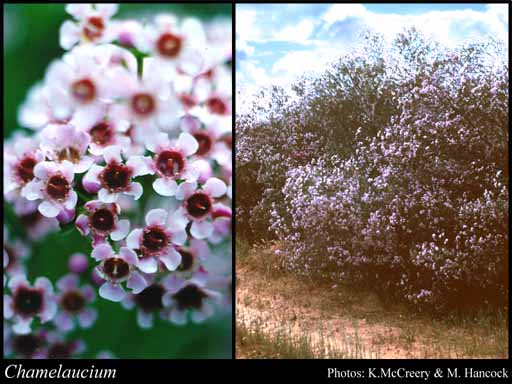- Reference
- Mém.Mus.Hist.Nat. 5:39-40 (1819)
- Name Status
- Current







Scientific Description
Common name. Wax Plants. Family Myrtaceae.
Habit and leaf form. Shrubs; evergreen; bearing essential oils. Plants with neither basal nor terminal concentrations of leaves; to 0.15–3 m high. Leptocaul. Helophytic to xerophytic. Leaves minute to medium-sized; opposite (or scattered, sometimes aggregated at ends of branches); decussate; ‘herbaceous’, or leathery; petiolate; gland-dotted; aromatic; edgewise to the stem, or with ‘normal’ orientation; simple; epulvinate. Leaf blades dorsiventral, or isobilateral, or centric; entire; solid; terete, or solid/angular (triquetrous); linear, or lanceolate, or oblong, or ovate; linear; pinnately veined, or parallel-veined, or one-veined; cross-venulate, or without cross-venules. Mature leaf blades adaxially glabrous, or pubescent (when margins ciliate); abaxially glabrous, or pubescent (when margins ciliate). Leaves without stipules; without a persistent basal meristem. Stem anatomy. Secondary thickening developing from a conventional cambial ring.
Reproductive type, pollination. Fertile flowers hermaphrodite (C. uncinatum and several other species protandrus). Unisexual flowers absent. Plants hermaphrodite. Entomophilous, or ornithophilous. Pollination mechanism conspicuously specialized (the anthers dehiscing in the bud, the pollen adhering to the stylar hairs as the stamens uncurl), or unspecialized.
Inflorescence and flower features. Flowers solitary, or aggregated in ‘inflorescences’; axillary; 1 per axil; in racemes, or in heads, or in corymbs. Inflorescences simple, or compound. The terminal inflorescence unit cymose. Inflorescences terminal, or axillary. Flowers pedicellate; (bi) bracteolate. Bracteoles persistent, or deciduous. Flowers small to medium-sized; regular; 5 merous; cyclic. Free hypanthium present (petals ‘inserted on the calyx’); turbinate, or campanulate, or obconic to tubular; smooth or ribbed, sometimes foveolate. Hypogynous disk present. Perianth with distinct calyx and corolla; 10; 2 -whorled; isomerous. Calyx present; 5; 1 -whorled; polysepalous, or gamosepalous (depending on interpretation). Calyx segments entire (or ciliolate). Calyx imbricate, or valvate; exceeded by the corolla (sometimes minute); regular. Sepals ovate, or obovate, or triangular. Calyx lobes ovate, or obovate, or triangular. Corolla present; 5; 1 -whorled; polypetalous; imbricate; regular; white, or yellow to green, or red, or pink, or purple; persistent. Petals ovate, or obovate, or orbicular. Corolla members entire (or ciliolate or irregularly dentate). Androecial members definite in number. Androecium 20–25. Androecial members branched. Androecial sequence determinable, or not determinable. Androecial members free of the perianth; all equal, or markedly unequal; coherent; 1 - adelphous (connate into a short ring, the stamens basally adnate to the adjacent staminodes); 1 -whorled. Androecium including staminodes. Staminodes 10(–12) (alternating with the stamens); non-petaloid (without anthers, simple, sometimes fringed). Stamens 10(–13); attached on the rim of the hypanthium; remaining included (not exceeding the petals); all more or less similar in shape; diplostemonous (usually); alternisepalous and oppositisepalous; both opposite and alternating with the corolla members; erect in bud, or inflexed in bud. Anthers all alike; dorsifixed; versatile; dehiscing via longitudinal slits; introrse; cells parallel; tetrasporangiate; appendaged (when the connective gland conspicuous), or unappendaged. Pollen in lipidic fluid suspension. Gynoecium 2 carpelled. The pistil 1 celled. Gynoecium syncarpous; eu-syncarpous; inferior, or partly inferior. Ovary unilocular; 1 locular. Epigynous disk present, or absent. Gynoecium stylate. Styles 1; apical; shortly becoming exserted, or not becoming exserted; hairy (with a ring of hairs subtending the stigma that present the pollen, then remove it from the vicinity of the stigma prior to the period of stigmatic receptivity). Stigmas 1. Placentation parietal. Ovules in the single cavity 4–8; ascending (on intrusive placentas); non-arillate; anatropous.
Fruit and seed features. Fruit non-fleshy; indehiscent; a nut (formed by the dried, lower part of the hypanthium); 1 celled; 1 seeded. Seeds non-endospermic; winged, or wingless. Cotyledons 2.
Geography, cytology, number of species. Native of Australia. Endemic to Australia. Australian states and territories: Western Australia. South-West Botanical Province.
Etymology. Derivation uncertain; L.A.S. Johnson has proposed the Latin term applied to the headgear of medieval Popes: an illustration in the original description resembles a bishop's mitre.
Keys
A Key to Western Australian Species in the Chamelaucieae Tribe of Myrtaceae
B.L. Rye, M.D. Barrett, T.D. Macfarlane, N.S. Lander, M.E. Trudgen, N.G. Marchant, K.R. Thiele
Taxonomic Literature
- Wheeler, Judy; Marchant, Neville; Lewington, Margaret; Graham, Lorraine 2002. Flora of the south west, Bunbury, Augusta, Denmark. Volume 2, dicotyledons. Australian Biological Resources Study.. Canberra..
- Marchant, N. G.; Wheeler, J. R.; Rye, B. L.; Bennett, E. M.; Lander, N. S.; Macfarlane, T. D.; Western Australian Herbarium 1987. Flora of the Perth region. Part one. Western Australian Herbarium.. [Perth]..
- Blackall, William E.; Grieve, Brian J. 1980. How to know Western Australian wildflowers : a key to the flora of the extratropical regions of Western Australia. Part IIIA. University of W.A. Press.. [Perth]..